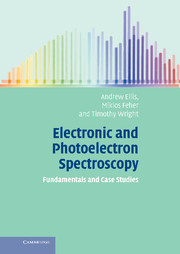Book contents
- Frontmatter
- Contents
- Preface
- List of journal abbreviations
- Part I Foundations of electronic and photoelectron spectroscopy
- Part II Experimental techniques
- Part III Case Studies
- 13 Ultraviolet photoelectron spectrum of CO
- 14 Photoelectron spectra of CO2, OCS, and CS2 in a molecular beam
- 15 Photoelectron spectrum of NO–2
- 16 Laser-induced fluorescence spectroscopy of C3: rotational structure in the 300 nm system
- 17 Photoionization spectrum of diphenylamine: an unusual illustration of the Franck–Condon principle
- 18 Vibrational structure in the electronic spectrum of 1,4-benzodioxan: assignment of low frequency modes
- 19 Vibrationally resolved ultraviolet spectroscopy of propynal
- 20 Rotationally resolved laser excitation spectrum of propynal
- 21 ZEKE spectroscopy of Al(H2O) and Al(D2O)
- 22 Rotationally resolved electronic spectroscopy of the NO free radical
- 23 Vibrationally resolved spectroscopy of Mg+–rare gas complexes
- 24 Rotationally resolved spectroscopy of Mg+–rare gas complexes
- 25 Vibronic coupling in benzene
- 26 REMPI spectroscopy of chlorobenzene
- 27 Spectroscopy of the chlorobenzene cation
- 28 Cavity ringdown spectroscopy of the a1Δ ← X3Σ–g transition in O2
- Appendix A Units in spectroscopy
- Appendix B Electronic structure calculations
- Appendix C Coupling of angular momenta: electronic states
- Appendix D The principles of point group symmetry and group theory
- Appendix E More on electronic configurations and electronic states: degenerate orbitals and the Pauli principle
- Appendix F Nuclear spin statistics
- Appendix G Coupling of angular momenta: Hund's coupling cases
- Appendix H Computational simulation and analysis of rotational structure
- Index
- References
23 - Vibrationally resolved spectroscopy of Mg+–rare gas complexes
Published online by Cambridge University Press: 05 June 2012
- Frontmatter
- Contents
- Preface
- List of journal abbreviations
- Part I Foundations of electronic and photoelectron spectroscopy
- Part II Experimental techniques
- Part III Case Studies
- 13 Ultraviolet photoelectron spectrum of CO
- 14 Photoelectron spectra of CO2, OCS, and CS2 in a molecular beam
- 15 Photoelectron spectrum of NO–2
- 16 Laser-induced fluorescence spectroscopy of C3: rotational structure in the 300 nm system
- 17 Photoionization spectrum of diphenylamine: an unusual illustration of the Franck–Condon principle
- 18 Vibrational structure in the electronic spectrum of 1,4-benzodioxan: assignment of low frequency modes
- 19 Vibrationally resolved ultraviolet spectroscopy of propynal
- 20 Rotationally resolved laser excitation spectrum of propynal
- 21 ZEKE spectroscopy of Al(H2O) and Al(D2O)
- 22 Rotationally resolved electronic spectroscopy of the NO free radical
- 23 Vibrationally resolved spectroscopy of Mg+–rare gas complexes
- 24 Rotationally resolved spectroscopy of Mg+–rare gas complexes
- 25 Vibronic coupling in benzene
- 26 REMPI spectroscopy of chlorobenzene
- 27 Spectroscopy of the chlorobenzene cation
- 28 Cavity ringdown spectroscopy of the a1Δ ← X3Σ–g transition in O2
- Appendix A Units in spectroscopy
- Appendix B Electronic structure calculations
- Appendix C Coupling of angular momenta: electronic states
- Appendix D The principles of point group symmetry and group theory
- Appendix E More on electronic configurations and electronic states: degenerate orbitals and the Pauli principle
- Appendix F Nuclear spin statistics
- Appendix G Coupling of angular momenta: Hund's coupling cases
- Appendix H Computational simulation and analysis of rotational structure
- Index
- References
Summary
Concepts illustrated: ion–molecule complexes; photodissociation spectroscopy; symmetries of electronic states; spin–orbit coupling; vibrational isotope shifts; Birge–Sponer extrapolation.
Laser-induced fluorescence, resonance-enhanced multiphoton ionization, and cavity ringdown spectroscopic techniques offer ways of detecting electronic transitions without directly measuring light absorption. An alternative approach is possible if the excitation process leads to fragmentation of the original molecule. By monitoring one of the photofragments as a function of laser wavelength, a spectrum can be recorded. This is the basic idea behind photodissociation spectroscopy.
There are limitations to this approach. If photodissociation is slow, then the absorbed energy may be dissipated by other mechanisms, making photodissociation spectroscopy ineffective. It is also possible that some rovibrational energy levels in the excited electronic state will lead to fast photofragmentation whereas others will not. In this case there will be missing or very weak lines in the spectrum which, in a conventional absorption spectrum, may have been strong. Fast photofragmentation is clearly desirable on the one hand, but it can also be a severe disadvantage if it is too fast, since it may lead to serious lifetime broadening in the spectrum (see Section 9.1).
Despite the above limitations, photodissociation spectroscopy can provide important information. This is particularly true for relatively weakly bound molecules and complexes, since these have a greater propensity for dissociating. In this and the subsequent example the capabilities of photodissociation spectroscopy are illustrated by considering weakly bound complexes formed between a metal cation, Mg+, and rare (noble) gas (group 18) atoms.
- Type
- Chapter
- Information
- Electronic and Photoelectron SpectroscopyFundamentals and Case Studies, pp. 187 - 196Publisher: Cambridge University PressPrint publication year: 2005



